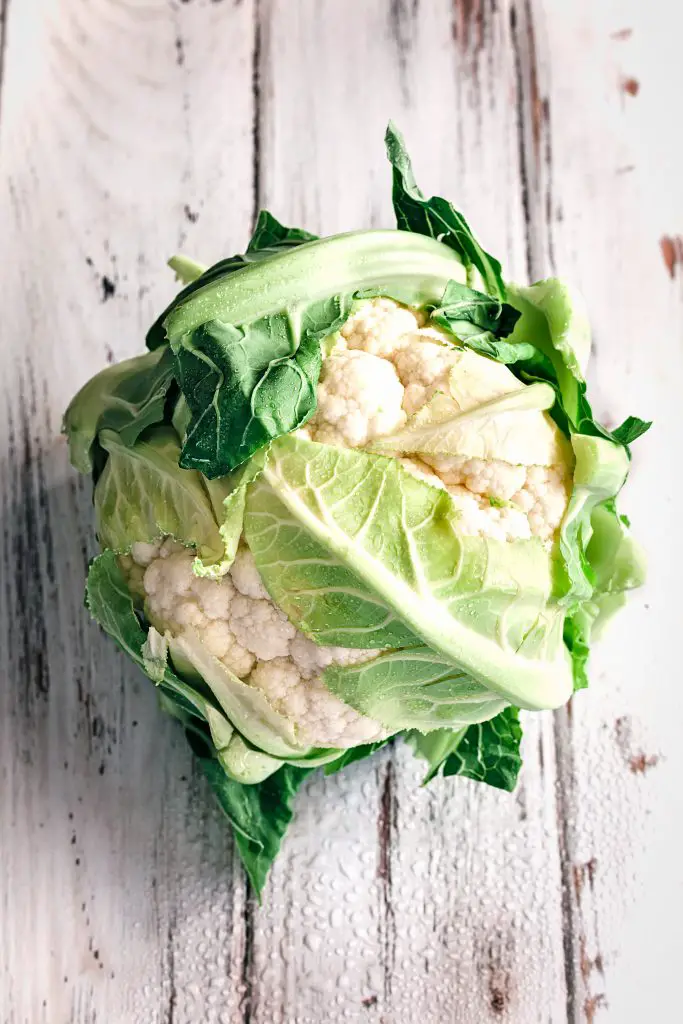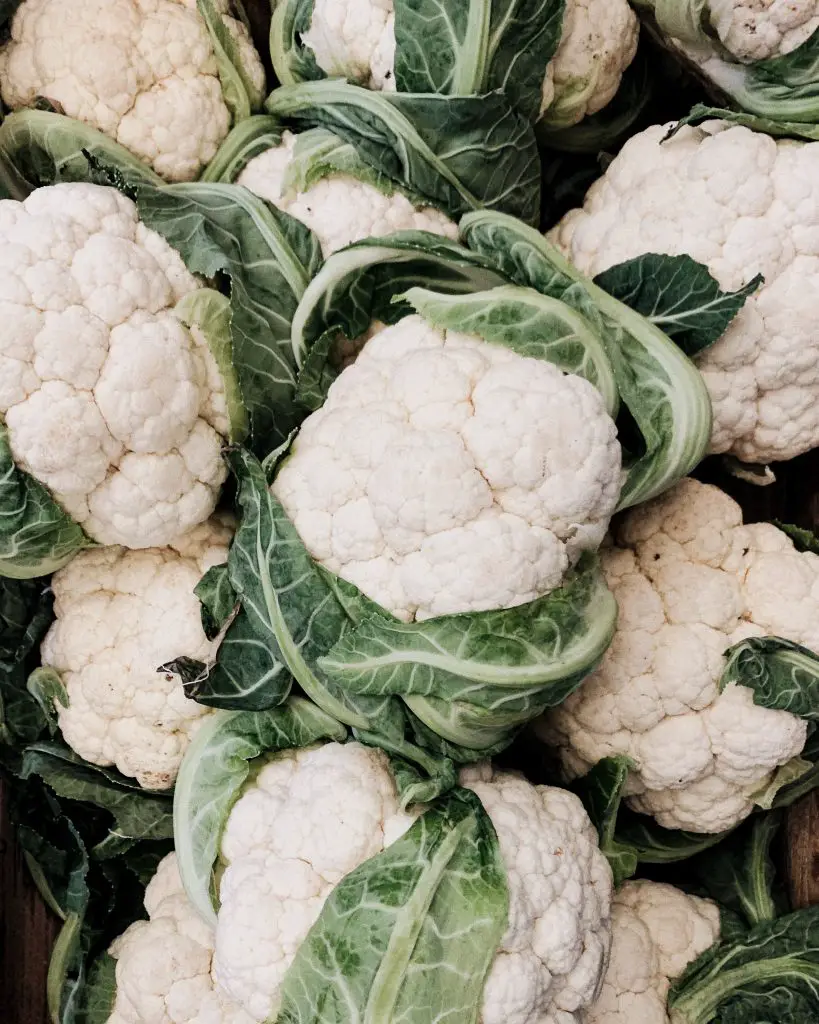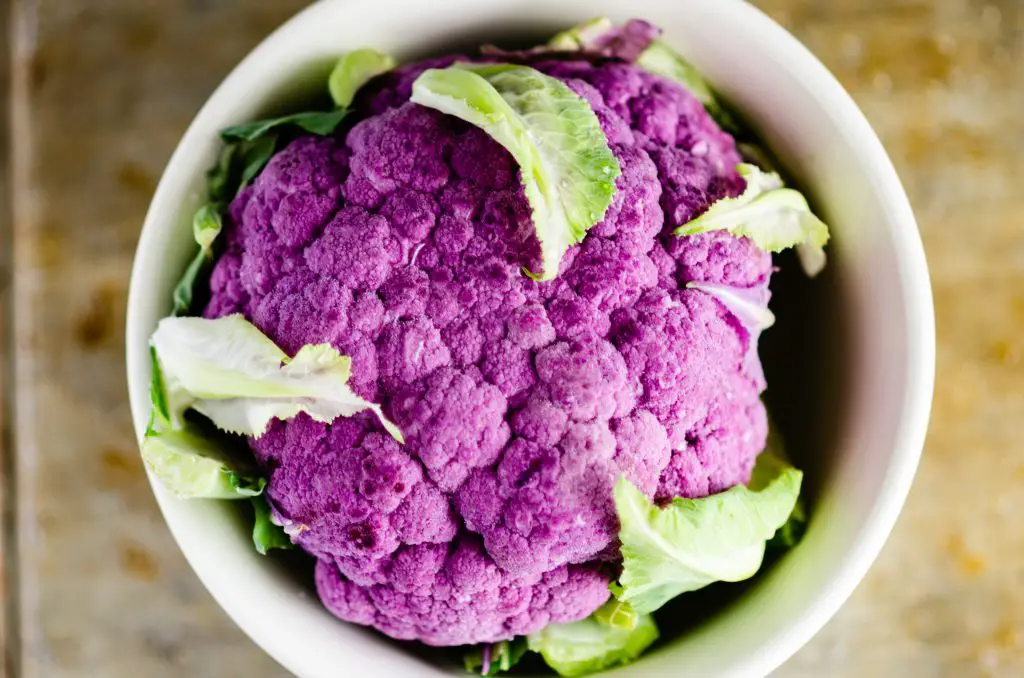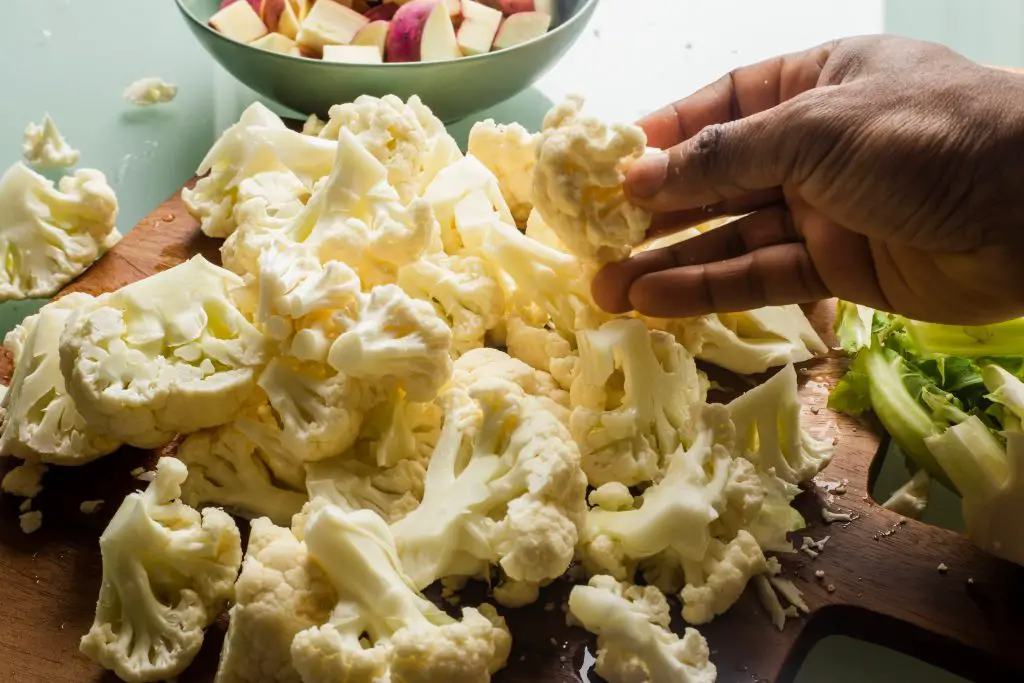Why is My Cauliflower Yellow? The Cauliflowers that are sold in the supermarket are traditionally white, although they are now available in green, purple and orange. However, you may have noticed that when growing your own that the white heads of the cauliflower can begin to yellow and they generally don’t look at as appetizing. So why does this happen and what can I do about it?
The colour of white Cauliflower curds will begin to yellow as they mature if exposed to the sun for too long. This discoloration does not affect the taste, but it does not make the vegetable look quite so appealing. To avoid this discoloration the head of the cauliflower needs to be protected from sunlight. This can be achieved by tying the outer leaves of the plant up over the head using a rubber band, a piece of string, or even a peg to exclude light. Check out the video below to see a few extra tricks and tips.
Alternatively, self-blanching varieties can be grown which produce leaves that cover the head of the cauliflower naturally. A list of some of these varieties is provided later in the article. However, to get additional information we highly recommend that you visit our vegetable database as it provides information on over 100 different cultivars.
When growing cauliflower that is not self-blanching the ideal time to tie the outer leaves over the head is when the head is around 5 cm (2 inches) in diameter. This can be done by lifting the outer leaves up over the head and tying them together with a piece of twine. This will exclude light from the head, ensuring that it is white when harvested.
Check heads daily, two weeks after the manual blanching has been done, to make sure the head remains tight, and hard. Allow the heads to grow as long as they stay compact. Ideally, the head will reach a size of 20 cm (8 inches) in diameter, before they begin to spread.

What Is A Self-Blanching Cauliflower Variety?
A self-blanching Cauliflower variety is one in which the outer leaves of the vegetables grow over the top of the central head. The advantage of this growth habit is that it excludes light from the head of the Cauliflower, preventing it from yellowing. Below is a list of 12 white self-blanching varieties. In my garden, I most commonly grow the ‘Snowball’ variety which is available from Amazon or plant specialists such as Seeds Now if you live in the US. Seeds now is significantly cheaper than Amazon usually. If you live in the UK try Thompson & Morgan.
| 1 | Amazing |
| 2 | Andes |
| 3 | Apex |
| 4 | Early Snowball |
| 5 | Early White |
| 6 | First White |
| 7 | Fremont |
| 8 | Self-Blanche |
| 9 | Skywalker |
| 10 | Snow Crown |
| 11 | Snowball |
| 12 | Veitch’s Self-Protecting |

How To Grow Cauliflower
The cauliflower is a member of the brassica family which includes cabbage, kale, brussels sprouts, and kohlrabi, with its nearest relative being broccoli. It is believed to have originated around the Mediterranean, however, the most familiar modern forms originated in Italy, approximately 500 years ago.
Cauliflower is generally more difficult to grow than Broccoli because it is a relatively heat-sensitive vegetable and performs best in regions with milder summers. In regions with hot Summers, it is recommended that planting be delayed until late Summer to ensure that the heads avoid the worst of the Summer heat when harvesting.
For those living in milder climates, Cauliflowers can be grown through the winter if it is not too cold. Typically, they can tolerate temperatures as low as -3°C (26°F). In these regions, it is best to plant seeds in late winter and late summer.

Plants can be established by direct sowing into the soil, however planting in modular trays is recommended, as this provides protection from pests such as slugs, which can destroy your seedlings. If you live in a particularly cold climate and want to get an early start with growing the cauliflower it is recommended that a heat propagation tray be used as it will ensure that the growing conditions are ideal.
If you don’t currently own a heated propagation tray and wish to purchase the one we recommend is the iPower Heating Seed Starter Germination Kit, shown in the picture below largely because it has a vented humidity dome and is relatively inexpensive. Click on the link to see the current price on Amazon.

After 4 to 6 weeks, seedlings are generally large enough to be planted out at a spacing of 40-50 cms (16-20 inches). At the point of planting, it is best if the temperature exceeds 7°C (45°F) to ensure a reasonable rate of growth. When planting out in Summer or early Autumn, it is best to plant out seedlings when the typical peak daytime temperature is less than 24°C (75°F).
Cauliflowers prefer an area with at least 6-8 hours of sun per day. The soil needs to be rich, containing lots of compost and manure. During the growing season, many books recommended liquid plant food be applied regularly. However, I have found that if the soil preparation is adequate initially or the no-dig method is being applied, it is generally not required.
To produce pure white heads the outer leaves can be tied over the top of the heads, using string or a rubber band. This will also help protect the plants from frost damage if growing them late in the season.
Cauliflowers should be harvested when the head reaches a reasonable size. If there are any signs of the curds within the head separating, it should be harvested immediately. This is because the quality of the head quickly deteriorates becoming grainy and discoloured. This process happens very quickly in warmer weather and it is the reason why harvesting at the peak of summer should be avoided. To read more about how to grow cauliflowers in warmer weather click here.
Comparison of White, Orange, Green & Purple Cauliflower
As mentioned earlier in the article, varieties of Cauliflower that are Green, Orange and Purple have started to appear in places like the local famer’s markets. While they are visually appealing, they do not have a significantly different taste or texture to the traditional white varieties. However, the one advantage is that there is no blanching required for the colourful varieties.

There is also only a slight difference in nutritional value. The orange Cauliflower, which came about due to a natural genetic mutation, contains elevated levels of Beta Carotene, which is responsible for the colour in orange Cauliflower and other vegetables such as Carrots and Squash. The green Cauliflower, also known as Broccoflower, is a hybrid of Broccoli and Cauliflower, also contains more Beta Carotene than traditional varieties.
The purple Cauliflower contains Anthocyanin, which offers anti-inflammatory, anti-viral, and anti-cancer benefits. Anthocyanin, which occurs in other red and purple vegetables, is responsible for the colour. The one disadvantage of Anthocyanins in purple Cauliflower is, that they have a tendency to leach out in water, which dulls it’s colour and can stain other vegetables it is cooked with. As such, it is best to cook it with a dry heat, such as roasting, grilling, or sautéing to retain its colour.
How to Store Cauliflower
To reduce the potential for yellowing, it is important to harvest the Cauliflower when it is in peak condition. This need to harvest relatively quickly can lead to a glut of Cauliflower at certain stages throughout the year. As such, the ability to successfully store Cauliflower is a must, to ensure a continuous supply from your garden.
Cauliflower is ideally stored in a cool and moist place, 0-4°C (32°-40°F) and 90 percent relative humidity. Refrigerators provide the cold but not the moisture. To increase the moisture, wrap unwashed cauliflower in a damp cloth or paper towel, and put it in a perforated plastic bag in the vegetable crisper draw. Under these conditions, the Cauliflower will keep for two to four weeks.
If refrigerator space is an issue, the Cauliflower can be stored in a root cellar, basement, shed, or garage. However, it is important to note that if the Cauliflower is stored below freezing or in low humidity conditions, the head will begin to discolour.

Cauliflowers may also be frozen, however, they need to be blanched prior to freezing, to ensure that the enzyme activity within the Cauliflower stops. This process is distinct from blanching, done during the growing process, as it requires the vegetable to be placed in boiling water for a short period of time, to prevent the loss of flavour, colour, and texture when frozen. If you are unfamiliar with how to blanch, the steps are provided below;
- Step 1: Wash the Cauliflower and Remove Any Leaves. Cut the Cauliflower into smaller pieces however, the size of these pieces depend on what type of recipe you want to use the Cauliflower in.
- Step 2: Blanch the Cauliflower by bringing a large pot of water to boil. Fill a large bowl with ice water, just prior to starting the blanching process. Once the pot is boiling, add your Cauliflower into the water. Cook 2 minutes, then remove from the pot and immediately plunge the Cauliflower into the ice water to cool, for around the same amount of time as the blanching, and then drain thoroughly.
- Step 3: Prepare the Cauliflower for Freezing, Then Freeze. Pack all of your blanched Cauliflower into plastic bags, or a suitable containers. Ensure each bag or container is labelled with dates.
Related Articles
Can Cauliflower Grow In Summer?
How Many Cauliflowers Do You Get From One Plant?
12 Tips To Boost Your Garden Output
When Should I Plant Winter Vegetables?
